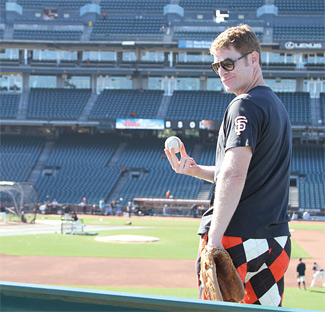Touring America's Ballparks in 3D
EL SEGUNDO, CALIF.—On DirecTV's new behind the scenes baseball series, "On Deck with Jamie and Mike" hosts Jamie Kaler and Mike Bunin take a 3D tour of some of American's great ballparks. The series is being shot using Panasonic's AG-3DA1 3D camcorder and both 2D and 3D versions are being edited on Final Cut Pro, giving DirecTV a cost-effective form of 3DTV production.

‘On Deck with Jamie and Mike’ host Jamie Kaler gets a 3D perspective on Candlestick Park, home of the San Francisco Giants. "This camcorder is good enough for broadcast," says series producer Bart Peters. "We pushed the limits with it, and the camcorder always performed."
WORKING ENVIRONMENT
"On Deck with Jamie and Mike" takes a light-hearted look at the world of baseball. This is why the series took Kaler and Bunin on a cross-country odyssey to Dodger Stadium, San Francisco's AT&T Ballpark, Comerica Park, Wrigley Field, Philly's Citizens Bank Park, and Boston's Fenway Park.
"We're taking the fans not just to the ballparks, but to places in those parks that they would never normally get to see," says Kaler; a comedian who stars with Bunin in the TBS sitcom "My Boys." "We go inside Fenway's 'Green Monster,' the various clubhouses and the scoreboards, and all kinds of other locales that are normally off-limits. Plus we take weird tours on trolleys, kayaks and Segways, and generally have a good time doing it. This is why 3D is absolutely perfect: It really takes you there in a way that 2D just can't."
Compared to conventional 3D camera rigs, the Panasonic AG-3DA1 is simplicity itself. Because the two lenses are built into a contained unit attached directly to the camcorder, setup is straightforward. Add the fact that the camcorder has a built-in dual video recording system—there's no requirement to use two separate external recorders—and the AG-3DA1 is very easy to use—just point and shoot.
That said, there are some limits to shooting 3D with this technology; limits that have more to do with 3D production itself, rather than the camcorder. "It all comes down to what's required to shoot properly in 3D," says Peters. "Because of the need to ensure proper convergence of the two 2D video streams to create a 3D image, you generally have to shoot at a fixed depth of field. This means that the talent can't run into the shot. They can go from one side to another, but their distance relative to the camcorder has to remain relatively constant. Otherwise the depth of field goes crazy; the viewer's eye can't adjust."
As a result of this limitation, "we ensured that our many 'run and gun' sequences were side to side," says Kaler. "We also tended to mount the camcorder on a tripod. You know how the Coen brothers fix their camera on a wide shot, and let the action take place in front of it? That was the approach we had to use. In general, handheld was too unstable to ensure that the 3D shot would work."
CONVERGENCE ISSUES

'On Deck' producers were also careful to avoid shots eight-feet or closer to the lens; again to ensure stable depth of convergence for the stereographer who had to render the show in post production. "This meant that we couldn't put the cameraperson in the back seat of a car and shoot forward, because Jamie and Mike would have been too close to the camera for the 3D effect to work properly," Peters said. "This also restricted us to three-quarter body shots," Kaler adds. "Anything closer just didn't look good."
3D's convergence issues meant that the show has been edited using longer visual sequences, because fast cuts that work in 2D are hard on the viewer's eyes in 3D. "That said, we were able to be innovative in our shooting," Peters said. "For instance, when the boys toured Chicago by kayak, we were able to follow them in a boat and get some astounding sequences. You really feel that you are there."
DirecTV's success in shooting "On Deck with Jamie and Mike" on a cost-effective 3D budget is a lesson to broadcasters everywhere: You can start to use 3D for local productions, even if only to wow your audiences on a special event basis.
"We proved that 3D works," says Kaler. "In fact, 'On Deck with Jamie and Mike' would not be as effective to bringing you along with us without 3D. Yes, there were a few constraints in using it, but the visual benefits far outweigh the limitations."
The professional video industry's #1 source for news, trends and product and tech information. Sign up below.
James Careless is an award-winning journalist who has written for TV Technology since the 1990s. He has covered HDTV from the days of the six competing HDTV formats that led to the 1993 Grand Alliance, and onwards through ATSC 3.0 and OTT. He also writes for Radio World, along with other publications in aerospace, defense, public safety, streaming media, plus the amusement park industry for something different.

